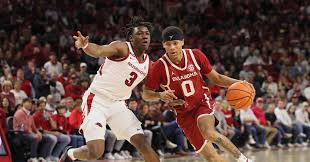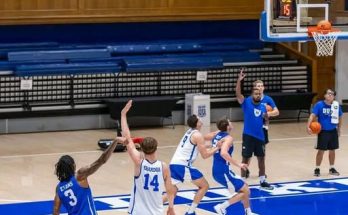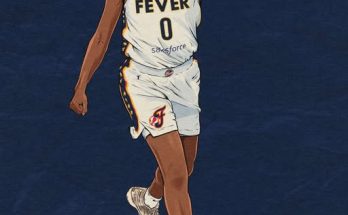Oklahoma Defeats Arkansas by Locking Down on Defense Late
In a thrilling clash of powerhouse college football programs, the Oklahoma Sooners overcame a resilient Arkansas Razorbacks squad, showcasing an impressive late-game defensive performance. The final score, 34-27, may not fully capture the tense, back-and-forth nature of the game, as Oklahoma’s defense delivered when it mattered most in the dying minutes of the contest.
As the two teams lined up for what promised to be an electric battle, few could have predicted just how much this game would test both squads’ willpower, coaching acumen, and ability to execute in high-pressure situations. Oklahoma, traditionally known for its offensive firepower, proved that the defensive side of the ball could be just as lethal when it counted.
The game unfolded in a way that highlighted both teams’ strengths, with Oklahoma relying on their versatile offense, and Arkansas pulling out every trick in the book to keep pace. But in the end, it was a surge of defensive stops by Oklahoma, particularly in the fourth quarter, that made all the difference.
The First Half: Offensive Explosion and Early Momentum Shifts
The game started with both teams exchanging offensive fireworks. Arkansas, led by quarterback KJ Jefferson, capitalized on their early drives, moving the ball with precision through the air and on the ground. Jefferson’s ability to create plays with his legs, as well as his arm, kept the Oklahoma defense on its heels in the early going. His touchdown pass to tight end Trey Knox, a 22-yard dart down the middle of the field, gave Arkansas an early 7-0 lead and set the tone for the high-scoring affair.
Oklahoma quickly responded. Quarterback Dillon Gabriel, who had been struggling with consistency in recent weeks, was sharp in the opening quarter, connecting with wide receivers like Marvin Mims and Drake Stoops on a variety of deep and intermediate routes. The Sooners’ quick-tempo offense, designed to stretch the defense, made it difficult for Arkansas to settle into a rhythm. Running back Eric Gray, known for his patience and vision, punctuated Oklahoma’s opening drive with a 16-yard touchdown run, capping a well-executed series that tied the game at 7-7.
From there, both offenses continued to trade blows. Arkansas had no intention of backing down, as Jefferson led the Razorbacks on another scoring drive in the second quarter. This time, the Arkansas quarterback found wide receiver Jadon Haselwood for a 36-yard touchdown, once again putting the Razorbacks in front. The Sooners, however, would answer quickly, with Dillon Gabriel finding Mims in the end zone for a 31-yard strike, leaving the game tied at 14-14.
The back-and-forth nature of the first half continued with both teams finding success on offense. Arkansas appeared to have gained the upper hand late in the second quarter, as a fumble recovery led to another touchdown, this time a 15-yard rushing touchdown by Raheim Sanders. The Razorbacks had taken a 21-14 lead with under two minutes left in the half.
However, Oklahoma refused to be rattled. In the final moments of the first half, Gabriel engineered a composed drive, highlighted by a few key completions to Stoops and tight end Brayden Willis. The Sooners moved the ball into Arkansas territory and tied the game at 21-21 with a short touchdown pass to Willis with just 30 seconds remaining before the break.
With the first half concluding in a 21-21 tie, it was clear that this game was far from over. Both teams had shown their offensive potency, but neither defense had been able to fully establish dominance. The second half would prove to be a much different story, however, as both teams would be forced to adjust their strategies and adapt to a rapidly changing game environment.
The Second Half: A Battle of Wits and Adjustments
As the teams returned from the locker rooms, it was evident that the second half would be a critical test of coaching adjustments. Arkansas, who had found success moving the ball through the air, sought to lean into their rushing attack, hoping to control the tempo and tire out Oklahoma’s defense. On the other hand, Oklahoma’s offensive coordinator Jeff Lebby made subtle adjustments, focusing on a quicker passing game and finding ways to keep the Arkansas defense guessing.
The Razorbacks came out firing in the second half, looking to seize control of the game. Jefferson opened the third quarter with a long, methodical drive that drained clock and ended in a 7-yard touchdown run by Sanders. Arkansas had regained the lead, 28-21, and seemed poised to take over.
But Oklahoma’s defense, which had been inconsistent throughout the game, made a crucial stand. After the touchdown, the Sooners held firm, forcing a critical three-and-out on Arkansas’s next possession. The Sooners’ defense, sparked by linebacker Danny Stutsman, made its first significant contribution of the game, and the momentum began to shift.
The Sooners quickly took advantage of the defensive stop, as Gabriel and the offense moved the ball downfield. With a combination of quick passes and a heavy dose of Gray in the running game, Oklahoma answered with a 10-play drive that ended with a 5-yard touchdown run from Gabriel. The game was once again tied, 28-28, and the crowd inside Gaylord Family Oklahoma Memorial Stadium was on its feet.
The Defensive Turnaround: Oklahoma’s Late Shutdown
As the game entered the fourth quarter, it was clear that the outcome would be decided by which team could make the necessary defensive stops. Arkansas was no longer able to impose its will on the ground, as Oklahoma’s defensive line began to dominate. Edge rusher Ethan Downs was a constant presence in the Arkansas backfield, and defensive backs such as Woodi Washington and Billy Bowman provided tight coverage on the Razorbacks’ wide receivers.
The Razorbacks’ offense, which had been so efficient in the first half, suddenly found itself bogged down. Arkansas, desperate to regain the lead, began to make mistakes. On a crucial third-and-long with just over 6 minutes remaining, Jefferson misfired on a pass attempt to Knox, resulting in an incomplete pass and another Arkansas punt.
Oklahoma, meanwhile, capitalized on its defensive resurgence. Gabriel continued to manage the offense efficiently, keeping Arkansas on its heels with precise throws and smart decisions. As the clock continued to wind down, the Sooners found themselves with an opportunity to take the lead for the first time since the early stages of the game.
The defining moment of the game came with just under 2 minutes left. After a string of methodical plays, Oklahoma faced a 3rd-and-3 from the Arkansas 18-yard line. Gabriel dropped back to pass and calmly surveyed the field. He found Willis wide open in the middle of the field for a 9-yard completion, putting the Sooners in the red zone. A few plays later, Gray capped the drive with a 2-yard touchdown run, giving Oklahoma a 34-28 lead.
With Arkansas now trailing, the Razorbacks had one final chance to respond. But Oklahoma’s defense, now fully locked in, was not about to allow a late-game rally. On the Razorbacks’ final possession, Stutsman intercepted a desperate pass from Jefferson, sealing the victory for Oklahoma.
Key Takeaways: Defense Wins Championships
While Oklahoma’s offense was sharp throughout the game, it was their defense that ultimately carried them to victory. The Sooners’ ability to lock down Arkansas in the fourth quarter, forcing crucial turnovers and stifling any offensive rhythm, was the difference-maker. For a team that had often been criticized for its defensive inconsistency, the late-game surge was a statement of growth and resilience.
Oklahoma’s defense, led by standout performances from Stutsman, Downs, and the secondary, made timely plays when it mattered most. Arkansas, for all its offensive firepower, could not execute in the final minutes, and the Sooners made sure to capitalize on every opportunity.
For Arkansas, the game will surely be a source of frustration. While their offense had its moments, the inability to finish drives and the missed opportunities in the fourth quarter ultimately cost them. The Razorbacks can take pride in the way they battled back throughout the game, but they will need to adjust if they want to contend with top-tier programs in the future.
For Oklahoma, this victory was a testament to their resilience and depth. While the Sooners’ offense has often been the focal point of their success, this win underscored the importance of a balanced team. The defense’s performance in the closing minutes was a promising sign for a squad that will need to continue evolving as they approach tougher challenges in the Big 12 and beyond.
In the end, it was Oklahoma’s ability to lock down on defense late in the game that secured the victory. The Sooners emerged victorious, 34-27, and left no doubt that when the game is on the line, defense can be just as pivotal as offense.
Conclusion
As the season progresses, Oklahoma’s thrilling win over Arkansas will likely serve as a reminder that college football is as much about adjustments and grit as it is about raw talent. With a defense that can rise to the occasion and an offense that knows how to score when needed, the Sooners have shown they can handle the pressure. Arkansas, on the other hand, will need to find ways to close out games more effectively if they hope to compete with the nation’s best.
For fans, players, and coaches alike, this game will be remembered as a classic example of how the tides of football can turn with a well-timed defensive stand. Oklahoma’s late-game heroics are a testament to the power of defensive strategy, and the Sooners will look to carry that momentum forward into the rest of the season.



